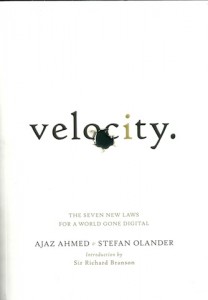The one-sentence summary
In a world gone digital, you need to act fast, create direct connections, take risks, and respect how people really feel.
WHAT THE BOOK SAYS 
- Velocity is the acceleration in the pace of social, cultural and commercial change brought about by digital technology.
- There are seven new laws for a world gone digital:
1. A Smith & Wesson beats four aces
There’s no such thing as a safe bet – thinking you know it all is dangerous.
2. It’s easier done than said
The best way to see if something works is to do it, not discuss it endlessly.
3. The best advertising isn’t advertising
Showing off and sweet-talking customers doesn’t work – you need direct connections.
4. Convenient is the enemy of right
A close cousin of ‘Good is the enemy of great’, this is the old, slightly macho point of constantly testing your limits.
5. Respect human nature
Proper use of data can provide the early signals about whether you are serving people properly.
6. No good joke survives a committee of six
Groupthink is more dangerous than being radical because it leaves brands and companies anonymous and unmentioned.
7. Have a purpose larger than yourself
This is pretty much the same as Daniel Pink’s purpose point – the suggestion is that individuals who aim to make a ‘meaningful and enduring contribution’ (their words, not mine) will be ‘disproportionately rewarded’ (in what way is unexplained).
WHAT’S GOOD ABOUT IT
- The basic velocity principles of speed, direction, acceleration and discipline are good sense in most markets.
- Good communication needs to create wonder, new media requires new thinking and mustn’t retrofit traditional mechanics, briefs should indeed be brief, and counting clicks isn’t what counts.
- The story goes that Wally Olins showed five corporate mission statements to the board of a pharmaceutical company and they were unable to identify their own.
- Clinical decision- making is crucial. When US Airways flight 1549 was hit by a flock of geese, the captain declared “my aircraft”, took control and landed it safely.
WHAT YOU HAVE TO WATCH
- The book takes the form of a conversation between the authors (which it obviously isn’t), and it’s a bit contrived.
- Because of the choice of examples, it’s pretty much a brochure for Nike and AKQA, the authors’ companies.
- Despite its claim to be jargon-free, it isn’t, resorting to most of the usual suspects including moving the needle, democratising the idea, monetising content, bandwagoneering, and the classic chasing eyeballs.
